Treatment of valgus deformity of the foot in a child under the age of 1 year and a few more leads to focus of the forecast — probability of eliminating the problem completely is close to 100%.
Among the orthopaedic diseases in children, the change of foot is the most common pathology. Represents the curvature of the lower end of the interior of this side. Develops under the influence of various external and internal factors. Changes the shape of the foot: offset of the axis, the heel looks to the outside, to the inside of the foot to the inside, the deformation of the fingers. When tight the knees of the distance between the pegs is 4-5 see
Apart from the identification, in the case of the disease in adolescence, you experience problems with the spine. That later started the treatment, the greater the likelihood of complete healing.
FACTORS AFFECTING THE DEVELOPMENT OF The HALLUX VALGUS deformity OF The CHILD
The deformation of the foot in the child happens to be a congenital or acquired pathology. In all cases, it is the wrong position off relative to the other. The changes lead to that the support when the market falls on their inner surface of the foot. The presence of symptoms in children up to 3 years says about changes at the stage of the pregnancy. The diagnosis orthopaedic surgeon after a thorough examination.
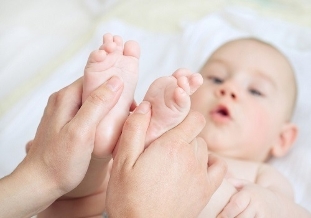
The factors an impetus to the development of the pathology, including:
- the lack of power supply;
- a bad diet;
- the lack of vitamins and minerals in the body (deficiency of calcium and/or vitamin D), leading to a fragility and softness of the bone tissue;
- ambulation early the child on the feet;
- properly selected footwear;
- the common complaints;
- injury of the ankle;
- prolonged immobility and the lower end in the plaster.
If the child begins early to walk (up to 1 year) or of his forcing the parents, in many cases, the stop is deformed. At an early age occurs the formation of ligaments, which, often, are not willing to the effort.
THE REASONS FOR THE FORMATION OF VALGUS OF THE FOOT
Birth defects bone or muscle of the child and of the deformities which develop during pregnancy in the mother, occurring after birth. The degree of curvature in innate hallux valgus is very expressed. This is due to a variety of disorders of the development of individual elements of the musculoskeletal system, abnormalities in a foetus's genes or chromosomes. Cases of violation of the location of the bones of the foot and of the form in utero. The deformation stop is already manifest in the first months after the appearance of the baby is the light.
An example of genetic of counterfeiting is the Edwards ' syndrome – a certain abnormality of the chromosomes during the meeting heavy the degree of curvature of the foot of the new-born – stop rocking.
Other reasons innate valgus of the foot of the child still applies a number of pathologies, which are diagnosed with the first weeks of life:
- in 80% of cases of dysplasia of the connective tissue with a trauma of the hip;
- myodystrophy;
- cerebral palsy;
- polio and other infections of the central nervous system;
- neuropathy – pathology of the peripheral nerves.
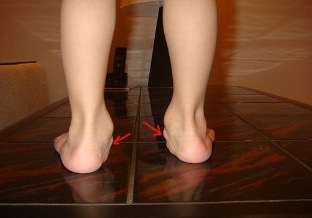
Acquisition of the form — the result of the impact of one or more factors already after birth of the child. Initially, the main reason is the weakness of the device the feet, because of a breach of its correct position. This condition is diagnosed in the first days after the birth of the child. On the development of the pathology can influence:
- the preterm delivery or the birth of a small mass of the body;
- excess weight in children;
- endocrine pathology (diabetes, hypothyroidism);
- metabolic disorders (osteoporosis, disorders of lipid and carbohydrate).
THE VISIBLE SIGNS OF THE PATHOLOGY
The pain in the legs at the end of the day the most frequent is the complaint of the child at the time of the deformation of the foot. Objectively, the pathology will manifest the following common features:
- unstable gait when walking out of the party;
- the formation on the sole corns;
- constantly divorced fingers;
- difficulties when you try to bring the heels together.
Defined three types of diseases:
- Cross — section- the extension of the front-foot with a tension of muscles and tendons, which are responsible for the extension of the fingers. It is the cause of the pain of the child.
- Longitudinal — is demonstrated by a change of approach, the shape of the foot (at its palpation appears to be a pain), fatigue of the long-term presence on the legs because of the discomfort and pain.
- Combined.
Mainly two types of deformities of the foot:
- X-shaped (when direct compressed the knees of the distance between the inner faces between the ankles is more than 5 cm, the foot that look to the outside);
- varus – Of-shape.
THE DEGREE OF DEVELOPMENT AND THE SEVERITY OF THE DISEASE
We distinguish four stages of development of the pathology:
- I — a mild form of the disease is characterized by a deformity of the foot is not more than 15°, is treated well;
- Phase II — the deviation up to 20°, applies a therapeutic treatment;
- III degree of deformation up to 30°, require a long intensive care unit;
- Stage IV — heavy – deviation from the standard is greater than 30°.
THE PATHOLOGY OF THE BIG FINGER OF FOOT
The deformation of the big toe in children can be self-pathology. The curvature of the first finger depends on the neglect of the pathology. The fix for the os is pass with the application:
- physio treatment;
- the installation orthotics;
- operation of the method.
THAT AND HOW TO TREAT?
The correction changes the stop in the child involves the restoration of the normal position of the joints, muscles and ligaments of the feet. The goal of the treatment of the possibility of walking without pain and discomfort. Therapy must be comprehensive. For the treatment of the valgus of the foot of the child are used:
- conservative;
- operational;
- another method (osteopathy can cure almost all, except genetically related, pathology).
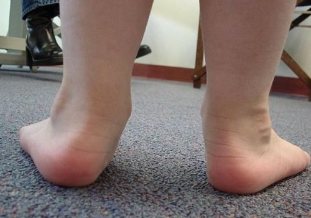
Conservative includes:
- drug;
- kinesiotherapy;
- orthotics;
- physiotherapy.
DRUGS
The medication in X-t violation of the lower limbs apply to relieve the inflammation and relieving the joints. The receipt of the NSAIDS (nonsteroidal anti-inflammatory drugs) or of the CSG allocated to symptomatic of the goal. They act briefly, dangerous for the organism of children of side effects.
NEW METHODS
The modern method of treatment is kinesiotherapy — the innovative technique of treatment and prevention of diseases of the musculoskeletal system. By its impact on the muscles using special band – kinesiotherapy. The method name formed by two words: "kinesiot" means the movement, "teip" – in fact a ribbon. Is of special taxation of strips of elastic fabric on the basis of sticky, not the caller of allergies. The method teip designed several years ago doctor japanese Kenzo Kase for the treatment of sports injuries. In addition, obtained a wide circulation. Kinesiotherapy in the hallux valgus deformity of the foot in children is widely applied in the last hour. This is due to the security of the methodology: while using lack limitation of motion, discomfort, you do not experience allergies.
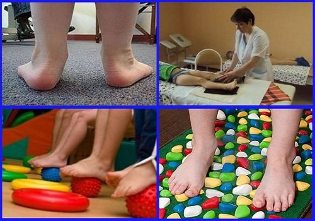
The fabric, from which is teip:
- has the structure of the fibers;
- well permeable to air;
- does not retain perspiration;
- does not lead to pain or discomfort;
- shall not bind the movements;
- not afraid of the water – you can swim, do not remove the tape.
The good collage teip speeds up the recovery of joints, ligaments and muscles without the use of medication, may stop the progression of pathological changes. This method is safe helping to:
- the cessation of the pain;
- prevent the progression of the disease;
- a complete healing.
The rules of kinesiotherapy:
- teip binds only on a clean and dry skin;
- for a longer operating time kinesiotype you need the edges to make round;
- after pasting teip rub activating it.
The ACTION OF MASSAGE
When the blade of the arch of the feet changes the muscle tissue, which leads to an alteration of the blood flow, and in the future – to the development of irreversible processes. Therefore, massage is an essential element of treatment. This is one of the methods of physiotherapy from the impact. That might be done for its implementation is not necessary, so that you can make at home. The rate is 10 sessions, if necessary, it is recommended to repeat every 3-4 months. The total time of the holding of a session of 20-30 minutes. It is necessary to begin with a total massage – baby in a lying position on the stomach, arms stretched along the body with the hands and turned on the side of the head. The movement and pressure of the hands should cause of the pain.
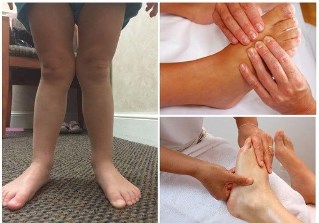
Child massage:
- of the folder;
- the lumbar region;
- of the buttock;
- the muscles and joints of the legs, the feet.
Use the following methods:
- caress;
- the trituration;
- kneading;
- tape;
- hits the back of the hand;
- pinch;
- shake.
The application of massage must:
- eliminate increase in the tonus of the muscles of the foot and leg;
- help get rid of excess tension;
- strengthen the weak muscles, which promotes the good functioning of the whole muscular apparatus;
- improve the blood circulation of muscles, ligaments, bones – which reinforces their power, normalizes the growth and development of the lower limbs;
- the healing of the pathology at an early stage.
The baby up to 2 weeks using this method are solved serious health problems, including hip dysplasia. In this case, apply structural therapy is especially designed methods, points, and vibrating massage. With their aid is diverted away from the load on the joints. The result of the impact – the improvement of the supply of blood and the disappearance of the pain.
PHYSIOTHERAPY
The application of physical therapy in the hallux valgus deformity of the foot in children can be used to repair the affected joint and cure the disease at an early stage. Widely used:
- foot bath;
- wrap off of the wax;
- the electrophoresis of the application of calcium;
- amplipulse therapy(the effects on the body-sinusoidal currents produced by the apparatus Amplipulse);
- wearing the right footwear;
- therapeutic swimming;
- physiotherapy;
- the magnetic therapy.
PLEASANT AND HELPFUL EXERCISES
In the early stages of the deformation of the child's foot is treated in the execution of the exercises. Their regular application lets you to repair almost all the joint problems. To do this, the elements of gymnastics need to perform every day. The appointment of exchange rates for the year individually, depends on the characteristics of the deformation. Included are elements of the game so that the child can meet the elements of a good number of times.
Every day, you need to:
- walk on the balls of the feet and the heels (first with arms raised, and then squeezed the fingers of feet) for 5 minutes;
- compress and decompress fingers, feet, sitting on the floor, arms outstretched to the feet;
- lift with a floor of small objects;
- walk barefoot on an uneven surface (you can do it at home on the pebbles ), on the outer edge of the foot;
- roll the foot roller or a small ball of wood;
- turn the feet left to right and vice-versa;
- crouch being off the ground.
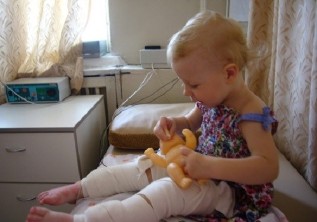
The child needs:
- walk on the narrow path, you can do it at home in fabric or simply draw;
- walk on бордюру in the street, while the summer barefoot on the earth, the sand, the grass.
GOOD SHOES IN THE TREATMENT IS VERY IMPORTANT
Properly chosen shoes over time can deform the foot and contort the thumb on the leg. Shoes of high quality, promotes the normal development of the muscles of the foot. At its choice it is necessary to take into account:
- the compliance of the size of the feet of comfort and convenience;
- manufacture from natural materials;
- the lack of treble of the nose and the heel in the shoe for a teenager.
Good shoes must have a closed rigid in the heel, the instep. The animals are not extended to wear sandals without the heel fixed.
For the treatment of the foot are recommended special orthopedic:
- outsole;
- attachment;
- jockstrap;
- the tire.
TO WALK OR NOT TO WALK BAREFOOT?
The best prevention of the problems of feet — bare feet. It must be done not only on a flat surface (the floor of the apartment), but on a rough terrain. If there is no possibility for the child to run out on the earth, grass and bumps, the alternative is to stall, that parents can buy and mount in the baby room of the child. Him to work all the muscles and ligaments of the foot when climbing. Are recommended for walking barefoot baby mat, embossed the items that you can buy in the store of the children or the night of the cabin.

WHEN REQUIRES SURGICAL TREATMENT?
The treatment of the curvature of the foot in childhood has held curator of the way. Radical intervention apply in the absence of the effect of treatment in older children, when the base of the musculoskeletal system that has already been formed, not growing and ligaments. The surgical correction consists of several stages of surgery and a long rehabilitation, is performed on the fourth stage of the disease, when:
- intense pain in the foot to disturb constantly;
- develops rigidity (stiffness) of the joint.
Types of direct intervention a lot. Therefore, the operation is planned on the basis of the extent of the disease of the foot, the presence of the deviation angle of the branch.
THE POSSIBLE CONSEQUENCES OF HALLUX VALGUS FOOT IN CHILDREN
The sick of the foot lead to changes in the musculoskeletal system. This is due to a load. Occurs:
- shortening and deformation of the feet;
- osteochondrosis;
- scoliosis of different divisions of the vertebral column.
For the child:
- abme of the process;
- becomes impossible to the physical activity (running, active play) because of the pain and inflammation in the joints.





































